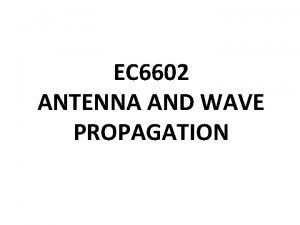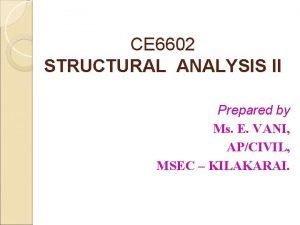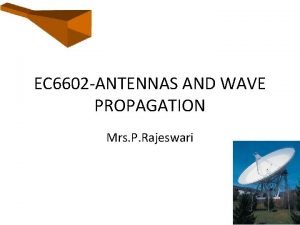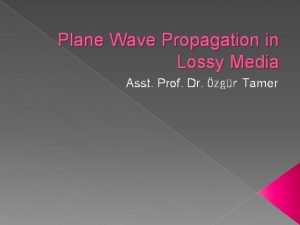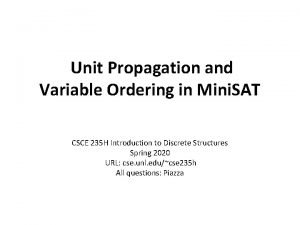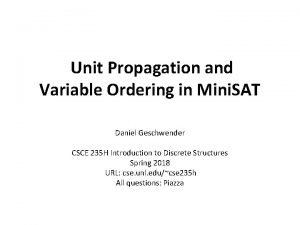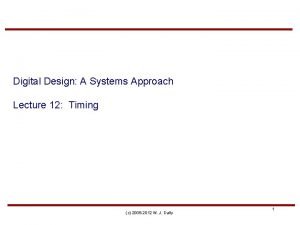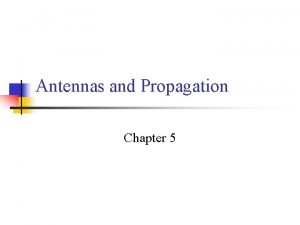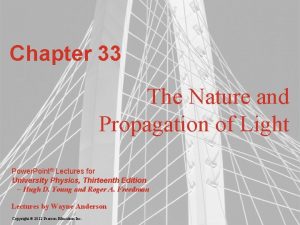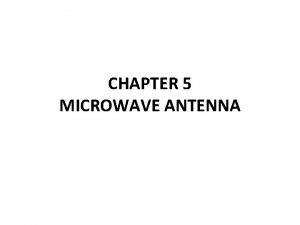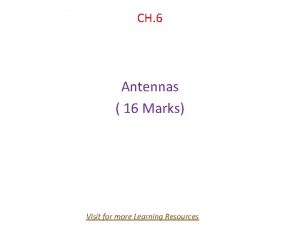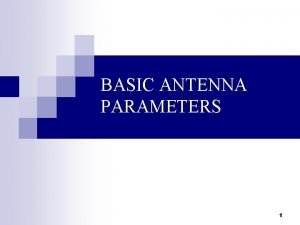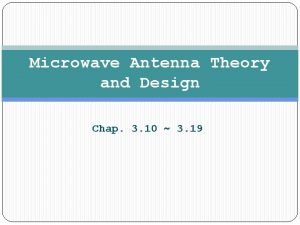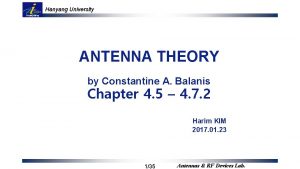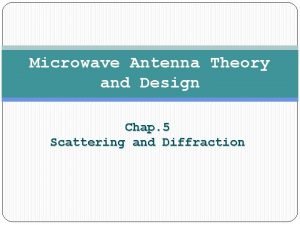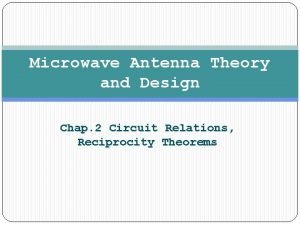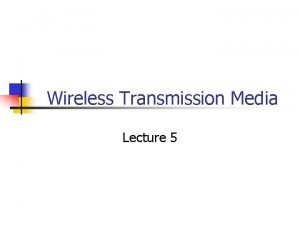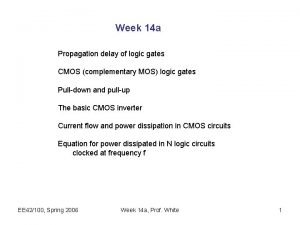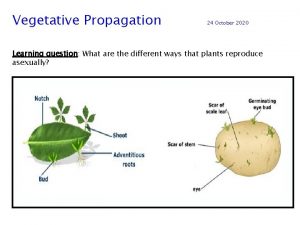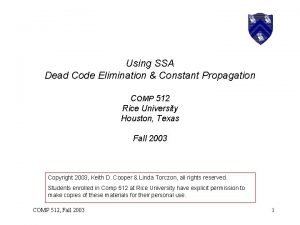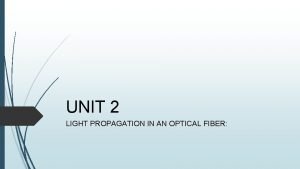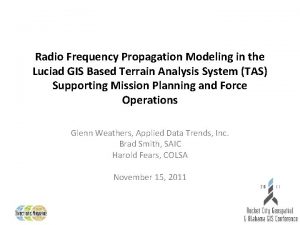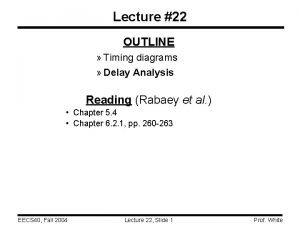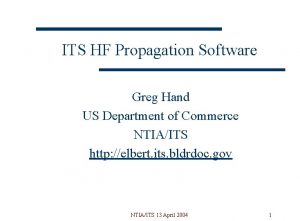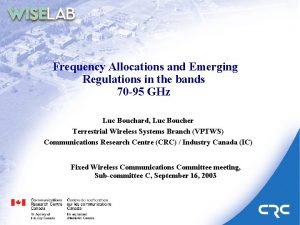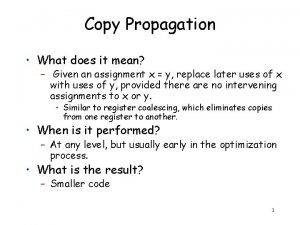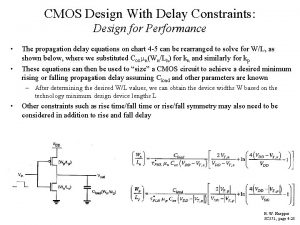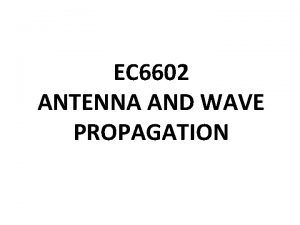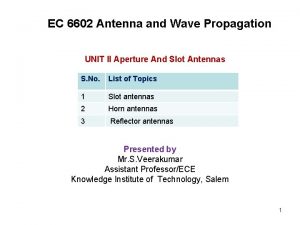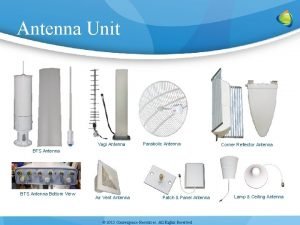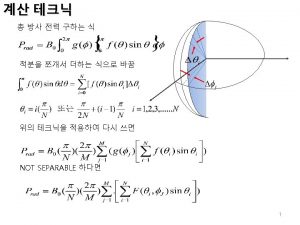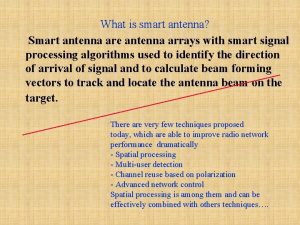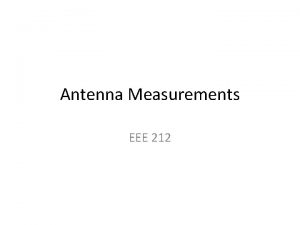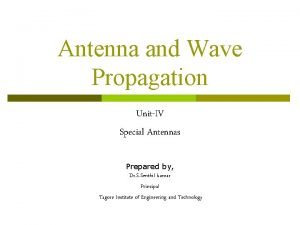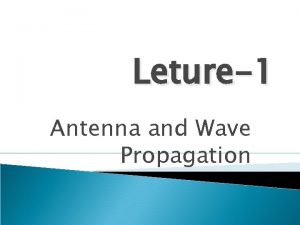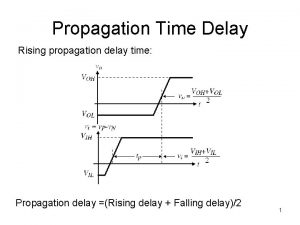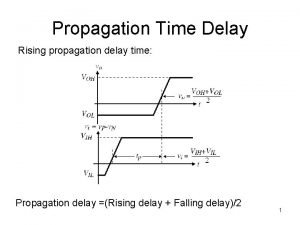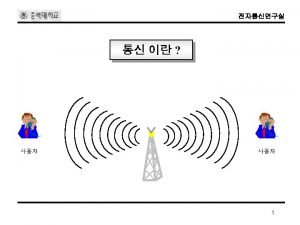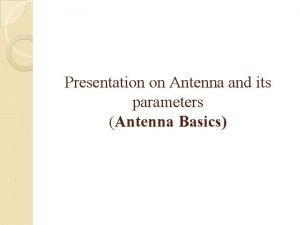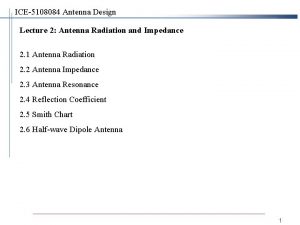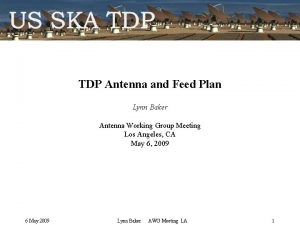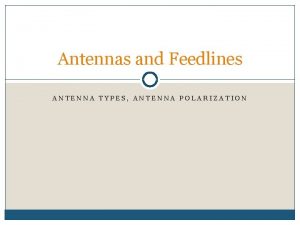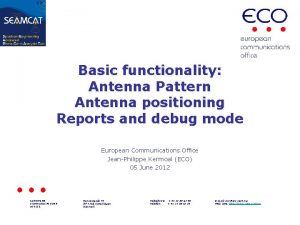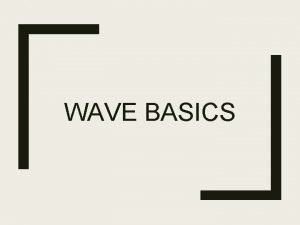EC 6602 ANTENNA AND WAVE PROPAGATION UNIT I












![Radiation Intensity • Is the power density per solid angle: [W/sr] Radiation Intensity • Is the power density per solid angle: [W/sr]](https://slidetodoc.com/presentation_image/2cb54a31a0e8d4185d85bb6efd789e21/image-13.jpg)









































- Slides: 54

EC 6602 ANTENNA AND WAVE PROPAGATION

UNIT I FUNDAMENTALS OF RADIATION • Definition of antenna parameters : – Gain, – Directivity, – Effective aperture, – Radiation Resistance, – Band width, – Beam width, – Input Impedance. • Matching – Baluns, • Polarization mismatch, • Antenna noise temperature, • Radiation from oscillating dipole, Half wave dipole. Folded dipole, Yagi array.

Antenna Background • • • Maxwell (1831 -79) Fundamental equations. (Scottish) Hertz (1857 -94) First aerial propagation (German) Marconi (1874 -1937) Transatlantic transmission (Italian) De. Forest (Triode tube 1920) Signal generators (American) World War II (1939 -45) Intense war-driven development

What is an Antenna? Ø An antenna is a way of converting the guided waves present in a waveguide, feeder cable or transmission line into radiating waves travelling in free space, or vice versa. ØAn antenna is a passive structure that serves as transition between a transmission line and air used to transmit and/or receive electromagnetic waves. Ø Converts Electrons to Photons of EM energy ØIt is a transducer which interfaces a circuit and freespace

Only accelerated (or decelerated) charges radiate EM waves. A current with a time-harmonic variation (AC current) satisfies this requirement. 5

The role of antennas Antennas serve four primary functions: • Spatial filter directionally-dependent sensitivity • Polarization filter polarization-dependent sensitivity • Impedance transformer (50 Ω to 377Ω) transition between free space and transmission line • Propagation mode adapter from free-space fields to guided waves (e. g. , transmission line, waveguide) 6

Antenna types Helical antenna 7 Horn antenna Parabolic reflector antenna

Antenna parameters • • • Solid angle, WA and Radiation intensity, U Radiation pattern, Pn, sidelobes, HPBW Far field zone, rff Directivity, D or Gain, G Antenna radiation impedance, Rrad Effective Area, Ae All of these parameters are expressed in terms of a transmission antenna, but are identically applicable to a receiving antenna. We’ll also study:

Isotropic antenna • It’s an hypothetic antenna, i. e. , it does not exist in real life, yet it’s used as a measuring bar for real antenna characteristics. • It’s a point source that occupies a negligible space. Has no directional preference. • Its pattern is simply a sphere so it has , beam area (WA) = Wisotropic= 4 p [steradians].

Isotropic Radiator: A hypothetical lossless antenna having equal radiation in all directions. Omnidirectional Radiator: An antenna having an essentially nondirectional pattern in a given plane (e. g. , in azimuth) and a directional pattern in any orthogonal plane. Directional Radiator: An antenna having the property of radiating or receiving more effectively in some directions than in others. Usually the maximum directivity is significantly greater than that of a half-wave dipole.

Spherical coordinates z (zenith) q=0 q q=90 f f= azimuth q= elevation x q=90 f=0 y

Solid Angle s = qr = arco s 1 = r dq s 2 = r sin q dø d. A = s 1 s 2 d. A = r 2 sin q dø dq = r 2 dΩ
![Radiation Intensity Is the power density per solid angle Wsr Radiation Intensity • Is the power density per solid angle: [W/sr]](https://slidetodoc.com/presentation_image/2cb54a31a0e8d4185d85bb6efd789e21/image-13.jpg)
Radiation Intensity • Is the power density per solid angle: [W/sr]

Radiation Pattern • A radiation pattern is a three-dimensional, graphical representation of the far-field radiation properties of an antenna as a function of space coordinates. The far-field region is a region far enough for the radiation pattern to be independent of the distance from the antenna. The radiation pattern of a particular antenna can be measured by experiment or can be calculated, if the current distribution is known. • Typically measured in two planes: – E Plane – H Plane Field pattern: Power pattern:

Radiation pattern – variation of the field intensity of an antenna as an angular function with respect to the axis Three-dimensional representation of the radiation pattern of a dipole antenna 15

Radiation Pattern Characteristics • • • 3 d. B beamwidth (HPBW) Sidelobes Nulls Front-to-back ratio Gain (approximate) • Maximum signal position 16

Antenna Pattern Parameters




Directivity and GAIN “The ratio of the radiation intensity in a given direction from the antenna to the radiation intensity averaged over all directions. ” Max Radiation intensity from subject or test antenna Max Radiation Intensity from reference (Isotropic)antenna with same power input. G=ηD

Directivity and GAIN of an Antenna ØThe Directivity or Gain of an antenna is defined as the ratio of the maximum value of the power radiated per unit solid angle to the average power radiated per unit solid angle ØDirectivity is a fundamental antenna parameter. It is a measure of how 'directional' an antenna's radiation pattern is. An antenna that radiates equally in all directions would have effectively zero directionality, and the directivity of this type of antenna would be 1 (or 0 d. B). Ø It measures the power density of the antenna radiates in the direction of its strongest emission, versus the power density radiated by an ideal Isotropic Radiator (which emits uniformly in all directions) radiating the same total power. Ø Directivity is a component of its Gain, If lossless antenna, G=D

Gain or Directivity An isotropic antenna and a practical antenna fed with the same power. Their patterns would compare as in the figure on the right.

Directivity and Gain • All practical antennas radiate more than the isotropic antenna in some directions and less in others. • Gain is inherently directional; the gain of an antenna is usually measured in the direction which it radiates best. “The directivity of an antenna is equal to the ratio of the maximum power density Pmax to its average value over a sphere as observed in the far field of an antenna”

Gain or Directivity • Gain is measured by comparing an antenna to a model antenna, typically the isotropic antenna which radiates equally in all directions.

Relation b/w Directivity, HPBW, WA • For an antenna with a single main lobe pointing in the zdirection , Beam area(WA) can be approximated to the product of the HPBW The Directivity:

Effective Aperture “A useful parameter in calculating the received power of an antenna is the effective area or effective aperture” Effective area or Effective aperture (square meters) The effective area corresponds to the effective absorbance area presented by an antenna to an incident plane wave. For an aperture antenna, it is equal to or smaller than the physical aperture. The relationship between the gain and the wavelength is


Effective Aperture It is also defined as the ratio of power received at the antenna load terminal to the poynting vector(or power density)in Watts/meter 2 of the incident wave. Thus Effective Area= Power Received Poynting Vector of incident wave Ae = W/P

Antenna Impedance Antenna Input impedance is very important because it is generally desired Ø to supply maximum available power from the transmitter to the antenna or Ø to extract maximum amount of received energy from the antenna.

Antenna Impedance • An antenna is “seen" by the generator as a load with impedance ZA , connected to the line. ZA • The real part is the radiation resistance plus the ohmic resistance. – Minimizing impedance differences at each interface will reduce SWR and maximize power transfer through each part of the antenna system. – Complex impedance, ZA , of an antenna is related to the electrical length of the antenna at the wavelength in use. • The impedance of an antenna can be matched to the feed line and radio by adjusting the impedance of the feed line, using the feed line as an impedance transformer. • More commonly, the impedance is adjusted at the load with an antenna tuner, a balun, a matching transformer, matching networks composed of inductors and capacitors, or matching sections such as the gamma match.

Antenna Impedance The radiation resistance does not correspond to a real resistor present in the antenna but to the resistance of space coupled via the beam to the antenna terminals.

Radiation Resistance • The antenna is a radiating device in which power is radiated into space in the form of electromagnetic waves. Hence there must be power dissipation which may be expressed in usual manner as W=I 2 R • If it is assumed that all this power appears as electromagnetic radio waves then this power can be divided by square of current i. e Rr=W/I 2 at a point where it is fed to antenna and obtain a fictitious resistance called as Radiation resistance.

Radiation Resistance • Thus “Radiation Resistance can be defined as that fictitious resistance which when substituted in series with the antenna will consume the same power as is actually radiated”. • Total Power loss in an antenna is sum of the two losses Total Power Loss = Ohmic Loss + Radiation Loss

Radiation Resistance The value of Radiation Resistance depends on: ü ü ü Configuration of Antenna The Point where radiation resistance is considered Location of antenna with respect to ground and other objects Ratio of length of diameter of conductor used Corona Discharge-a luminous discharge round the surface of antenna due to ionization of air etc.

So , Antenna Input Impedance is • Input Impedance (resistance + reactance) • Radiation Resistance (corresponds to energy that is transmitted) • Loss Resistance 36


Antenna Bandwidth • Antenna Bandwidth is the range of frequency over which the antenna maintains certain required characteristics like gain, front to back ratio or SWR pattern (shape or direction), polarization and impedance • It is the bandwidth within which the antenna maintains a certain set of given specifications.

fr=Centre or Resonant Frequency Q= 2π Total Energy Stored by antenna Energy Radiated or Dissipated per cycle Lower the “Q” of antenna higher is the bandwidth and vice versa

Antenna Bandwidth Most antenna technologies can support operation over a frequency range that is 5 to 10% of the central frequency (e. g. , 100 MHz bandwidth at 2 GHz) To achieve wideband operation requires specialized antenna technologies (e. g. , Vivaldi, bowtie, spiral) 40

Antenna Bandwidth • The bandwidth of an antenna is the range of frequencies over which it is effective, usually centered around the operating or resonant frequency. – The bandwidth of an antenna may be increased by several techniques, including using thicker wires, replacing wires with cages to simulate a thicker wire, tapering antenna components (like in a feed horn), and combining multiple antennas into a single assembly(Arrays) and allowing the natural impedance to select the correct antenna.

Bandwidth • For broadband antennas, the bandwidth is usually expressed as the ratio of the upper-to-lower frequencies of acceptable operation. For example, a 10: 1 bandwidth indicates that the upper frequency is 10 times greater than the lower. • For narrowband antennas, the bandwidth is expressed as a percentage of the frequency difference (upper minus lower) over the center frequency of the bandwidth. For example, a 5% bandwidth indicates that the frequency difference of acceptable operation is 5% of the center frequency of the bandwidth.


Baluns ØA balun is a device that joins a balanced line (one that has two conductors, with equal currents in opposite directions, such as a twisted pair cable) to an unbalanced line (one that has just one conductor and a ground, such as a coaxial cable). Ø So it's used to convert an unbalanced signal to a balanced one or vice versa. ØBaluns isolate a transmission line and provide a balanced output. ØA typical use for a balun is in television antenna.

Baluns • A balun is a type of transformer Used at RF – Impedance-transformer baluns having a 1: 4 ratio are used between systems with impedances of 50 or 75 ohms (unbalanced) and 200 or 300 ohms (balanced). Most television and FM broadcast receivers are designed for 300 -ohm balanced systems, while coaxial cables have characteristic impedances of 50 or 75 ohms. Impedance-transformer baluns with larger ratios are used to match high-impedance balanced antennas to lowimpedance unbalanced wireless receivers, transmitters, or transceivers. • Usually band-limited • Improve matching and prevent unwanted currents on coaxial cable shields • As in differential signaling, the rejection of common mode current is the most important metric for an antenna feed balun, although performance also requires proper impedance ratios and matching to the antenna.

Baluns Balun for connecting a center-fed dipole to a coaxial cable

Baluns As Impedance Transformers Transition from a 50Ώ coaxial cable to a 300 Ώ half-wave folded dipole through a four-toone impedance transformation balun




Forcing IC to be zero somehow - this is often called choking the current or a current choke is needed.

This balun adds a short-circuited sleeve around the coaxial cable to choke the Ic The green sleeve in Figures 1 and 2 acts as a transmission line

Balanced Unbalanced Television receiver Coaxial cable network Television receiver Coaxial antenna system FM broadcast receiver Coaxial antenna system Dipole antenna Coaxial transmission line Parallel-wire transmission line Coaxial transmitter output Parallel-wire transmission line Coaxial receiver input Parallel-wire transmission line Coaxial transmission line

 Effective aperture of antenna
Effective aperture of antenna Flexibility method
Flexibility method Ec 6602
Ec 6602 Lossy medium example
Lossy medium example Unit propagation example
Unit propagation example Unit propagation example
Unit propagation example Difference between full wave and half wave rectifier
Difference between full wave and half wave rectifier Longitudinal vs transverse waves
Longitudinal vs transverse waves Rectifier example
Rectifier example P and s wave arrival time chart
P and s wave arrival time chart Mechanical and electromagnetic waves
Mechanical and electromagnetic waves Examples of a mechanical wave
Examples of a mechanical wave Wavelength formula triangle
Wavelength formula triangle Sound waves are transverse waves true or false
Sound waves are transverse waves true or false What is a semiconductor used for
What is a semiconductor used for Examples of half wave rectifier
Examples of half wave rectifier Full wave rectified sine wave fourier series
Full wave rectified sine wave fourier series Nature of sound wave
Nature of sound wave The nature of waves chapter 10 section 1
The nature of waves chapter 10 section 1 Even quarter-wave symmetry
Even quarter-wave symmetry Propagation delay and contamination delay
Propagation delay and contamination delay Antennas and propagation
Antennas and propagation Nature and propagation of light
Nature and propagation of light Unit 10, unit 10 review tests, unit 10 general test
Unit 10, unit 10 review tests, unit 10 general test Omni-directional antenna advantages and disadvantages
Omni-directional antenna advantages and disadvantages Non resonant antenna
Non resonant antenna Current and voltage distribution in antenna
Current and voltage distribution in antenna Radiation pattern lobes
Radiation pattern lobes R=zcosθ
R=zcosθ Finite length dipole antenna
Finite length dipole antenna Microwave antenna theory and design
Microwave antenna theory and design Microwave antenna theory and design
Microwave antenna theory and design What is a wireless transmission media
What is a wireless transmission media Propagation delay in logic families
Propagation delay in logic families Vegetative propagation
Vegetative propagation Sparse conditional constant propagation
Sparse conditional constant propagation V number in optical fiber
V number in optical fiber Error of propagation
Error of propagation Absolute uncertainty multiplication
Absolute uncertainty multiplication Sparse conditional constant propagation
Sparse conditional constant propagation Konstanta saluran transmisi
Konstanta saluran transmisi Rf propagation modeling software
Rf propagation modeling software Ch3 cl2
Ch3 cl2 Propagation organic chemistry
Propagation organic chemistry Propagation delay timing diagram
Propagation delay timing diagram Error propagation equation
Error propagation equation Hf propagation software
Hf propagation software Long path propagation
Long path propagation Rf propagation
Rf propagation Relative uncertainty
Relative uncertainty Forward propogation
Forward propogation What is copy propagation
What is copy propagation Cmos power consumption
Cmos power consumption Propagation delay formula
Propagation delay formula Error propagation quotient
Error propagation quotient
